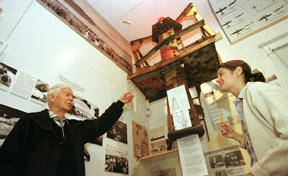What it lacked in blood, the home front more than made up in toil, tears and sweat.
For one Crystal Springs man, that meant rowing over to Illahee each morning at 3:30 a.m. with his wife, to catch a bus to the Bremerton shipyard.
Others saw long shifts in Eagle Harbor’s own yard, turning out minesweepers for service among distant, more tropical isles.
And for every family there were rationing and shortages, the domestic inconveniences of a global conflict: World War II.
“It was a scary time and a sad time, with a lot of sacrifice,” said Erica Varga, Bainbridge Island Historical Museum curator. “Spirited, though…
“Everybody had a shared purpose – to see an end to the war.”
Monday’s Veteran’s Day observance will include the opening of “World War II and Bainbridge Island: World Events, Local Effects,” a new exhibit at the museum in Strawberry Hill Park.
The display covers four years in the life of a community whose centrality to the war in the Pacific would come into focus only later – first as the secrets of Fort Ward were revealed, later as the nation re-examined the fears by which the rights of thousands of citizens were violated in internment, the first victims coming from Bainbridge.
The goal of the exhibit, Varga said, is to cast the oft-told tale of the Japanese-American internment in a fuller historical context: What else was happening in that time?
Various aspects of island life during wartime are identified: the top-secret naval radio facilities at Battle Point and Fort Ward, where Japanese military transmissions were intercepted; the construction of Navy minesweepers at the Winslow Marine Railway and Shipbuilding Co.; and the mundane yet extraordinary daily lives of those not called to active duty.
“Each of these subtopics,” Varga said, “could fill this room with an exhibit.”
Among the many photographs are some from the collection of longtime Rolling Bay resident Bill Weld. Drafted by the Navy but kept stateside for medical reasons, Weld did his shooting with a camera, documenting shipbuilding in Eagle Harbor.
“The guys down in the yard were really working,” he recalls. “They’d say, ‘I don’t know about you, Weld, pussyfooting around with a camera instead of going to war.’ I said, ‘Well, it’s up to the government.’”
The exhibit was crafted over a 12-month period, with the help of islanders like Weld who fought the war on Bainbridge. The project yielded a wealth of recollections and artifacts, many of them unique.
Included is the crown of Fort Ward’s massive radio antenna, which towered 320 feet over the south end of the island. Another is an original flier announcing the exclusion of Japanese Americans from Bainbridge, retrieved from a utility pole by a neighbor in March 1942 and saved for posterity.
The latter is one of several items contributed by island native and former Secretary of State Ralph Munro.
Before dawn each morning, parents George and Betty and the Munro children would set out by skiff for the Kitsap mainland, where George would board a bus for his job at the naval yard in Bremerton.
The elder Munro often worked double shifts “to help win this damn war and get it behind us.”
Outside the Munro home each evening, a government-issued poster cautioned visitors: “Quiet Please: War Worker Resting.”
The war’s incursion on domestic affairs can also be seen in a robust volume titled “War-Time Guide Book for the Home,” a “Make It Yourself, Fix It Yourself” tome that answers such questions as “What should I do in case of an air raid?”
A 1942 edition of “Women’s Home Companion,” meanwhile, ponders an equally essential issue: “Should marriage wait until after the war?”
But with hardship – the ration cards for commodities like gasoline and sugar – also emerges an upbeat picture of islanders finding normalcy and fun, through USO shows and swing dances at Foster’s Pavilion in Fletcher Bay.
Finally, the exhibit considers the internment itself, with the scholarship of Varga and other historians yielding fascinating insights.
Excerpts from President Franklin Roosevelt’s Executive Order 9066 reveal that the proclamation by which Japanese Americans were removed from coastal areas after Pearl Harbor actually made no reference to ethnicity.
The document skirts the issue, saying “any and all persons” could be excluded from the proximity of bases and wartime facilities. But its true intent is betrayed in the notes of Secretary of War Henry Stimson:
“If we base our evacuations upon the grounds of removing enemy aliens, it will not get rid of the Nisei (American citizens of Japanese descent), who as I said are the more dangerous ones.”
“World War II and Bainbridge Island: World Events, Local Effects” will be displayed indefinitely, and will evolve as new viewers add their own memories and artifacts.
“It was an exuberant time,” Varga said. “There were so many people coming and going from the island.
“They were volunteering to watch the skies or to serve on rationing boards – to help out in any way they could.”


